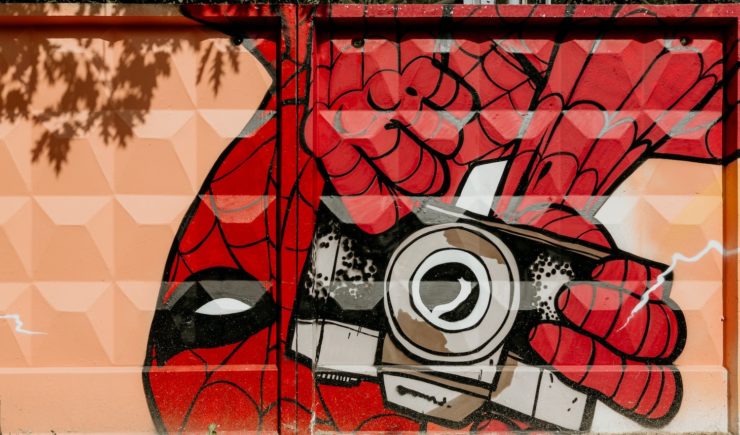When I was younger, I spent a fair amount of comic-reading time pondering questions like:
- How does Iron Man’s armor deal with the prodigious amount of heat it must generate?
- How is it that Batman always seems able to find a parking spot for the Batmobile?
- And—the actual subject of this essay—how it is that so many superheroes, dressed in garish eye-catching costumes, still seem to be able to sneak up on people at will?
I have come up with many possible explanations over the years but recent events have provided me with what I now think is the actual Watsonian answer.
What is this Watsonian view, you ask? TV Tropes explains all: when a creator answers a question about their work, should they provide an In-Universe answer or a Real Life answer? The former is the Watsonian perspective, the latter Doylist. That is, if you are bothered by something in the Sherlock Holmes canon, you can explain it as a hitherto unknown fact about the setting and characters (as Watson would do) or you can explain why the author, Conan Doyle, made the choice he did. Or made a mistake.
Before I reveal several possible Watsonian answers, I will first give you the Doylist answer to the question: how is it that superheroes in garish costumes can be sneaky?
The Doylist explanation is that superheroes wear colorful garb due to the limitations of early comics printing, as well as comic companies’ fondness for characters who were immediately recognizable and easily trademarked. The superheroes who are sneaky are sneaky because their creators said they were.
Buy the Book


Nona the Ninth
To be honest, once you grant premises like “became superfast because he got a transfusion of mongoose blood,” “can transfer his mind from android body to android body,” and “is a superpowered alien who nevertheless looks like a white American guy,” it’s hard to justify being skeptical about “is a bit sneaky.” Nevertheless, authorial fiat is a disappointing explanation.
A possible Watsonian answer might be that a lot of costumed characters spend their time lurking on rooftops. People for the most part do not look up. I’ve exploited this when working at theatres; I could monitor the audience for illicit food and drink from a conveniently elevated position, then relay the information to ushers on the main level. Astonishing as it may seem for a species whose ancestors may have been stalked by tree-branch-lurking great cats, humans focus on the horizontal to the near exclusion of the vertical. No audience member ever spotted me staring grimly down in quest of forbidden snackage.
Another, perhaps more convincing, Watsonian explanation might be that many superpowered characters have abilities that more than compensate for their eye-catching garb. The classic example is the Flash, whose bright red costume is more than made up for by his ability to go from over-the-horizon to in-your-face in an eye blink. Also he has a knack for vibrating such that he is invisible.
Another Watsonian possibility: the colorful costumes themselves are paradoxically stealthy. Perhaps they confuse the eye, making viewers think what they are looking at is farther away. Perhaps they are so bizarre, baffling and unexpected that they confound quick recognition.
This theory of concealment is no mere comic-fan hypothesis. It has had real-world proponents. Note such schemes as Dazzle Camouflage and Mountbatten Pink; consider Gerald H. Thayer’s remarkable Concealing-Coloration in the Animal Kingdom: An Exposition of the Laws of Disguise Through Color and Pattern; Being a Summary of Abbott H. Thayer’s Discoveries.
Unfortunately, experimental support for that idea is meager, but hey, so is evidence for people who can fly through sheer will alone.
However, recent experience as a mask-and-social distancing monitor (AKA space monitor) at a local university has revealed what I believe is a compelling, if disappointing, explanation. Note: space monitors do not get the jet pack and ray gun the title suggests. They get bright yellow vests. I’ve added a small embellishment. See if you can guess what it is.

Thanks to my theatre experience, I have developed many strategies for unexpected approaches. It turns out that, as space monitor, I need none of these. My largest challenge is getting people to notice me long enough for me to explain that masks are required on campus and how they are to be worn. I often have to plant myself directly in someone’s path before they see me.
The most likely Watsonian answer, as disappointing as it seems, is that a lot of humans are just incredibly comprehensively oblivious to their surroundings, even those people who are not fixedly looking at their phones. Unexpected details in direct view do not startle because unexpected details are simply not noticed.
The real mystery may be how the superheroes get people to pay attention to them at all.
In the words of Wikipedia editor TexasAndroid, prolific book reviewer and perennial Darwin Award nominee James Davis Nicoll is of “questionable notability.” His work has appeared in Publishers Weekly and Romantic Times as well as on his own websites, James Nicoll Reviews and the Aurora finalist Young People Read Old SFF (where he is assisted by editor Karen Lofstrom and web person Adrienne L. Travis). He is a four-time finalist for the Best Fan Writer Hugo Award, is eligible to be nominated again this year, and is surprisingly flammable.










